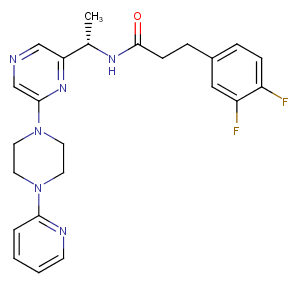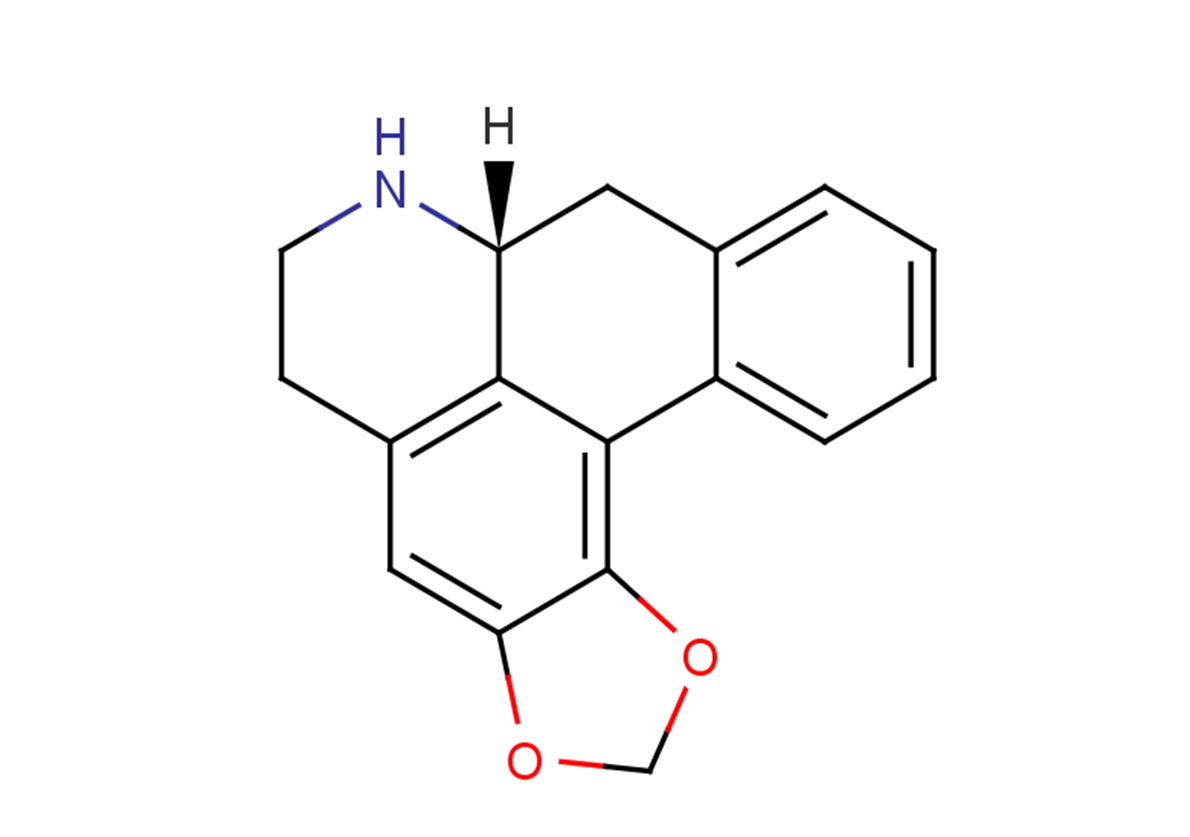?3-Truxilline
1 mg
| Purity Not Available
TargetMol
?3-Truxilline is a useful organic compound for research related to life sciences and the catalog number is T126362.
More Information
Supplier Page
?3-Truxilline
5 mg
| Purity Not Available
TargetMol
?3-Truxilline is a useful organic compound for research related to life sciences and the catalog number is T126362.
More Information
Supplier Page
TargetMol
TargetMol
TargetMol
TargetMol
TargetMol
TargetMol
TargetMol
TargetMol
TargetMol
(-)-(S)-Equol (4′,7-Dihydroxyisoflavan) is an orally bioavailable, non-steroidal estrogen naturally produced by the metabolism of the isoflavonoid daidzein by human intestinal microflora, with potential chemoprotective and estrogen receptor (ER) modulating activities. S-equol preferentially binds to and activates the beta isoform of ER in certain target tissues, while having an antagonistic effect in other tissues. This modulates […]
More Information
Supplier Page
TargetMol
(-)-(S)-Equol (4′,7-Dihydroxyisoflavan) is an orally bioavailable, non-steroidal estrogen naturally produced by the metabolism of the isoflavonoid daidzein by human intestinal microflora, with potential chemoprotective and estrogen receptor (ER) modulating activities. S-equol preferentially binds to and activates the beta isoform of ER in certain target tissues, while having an antagonistic effect in other tissues. This modulates […]
More Information
Supplier Page
TargetMol
(-)-(S)-Equol (4′,7-Dihydroxyisoflavan) is an orally bioavailable, non-steroidal estrogen naturally produced by the metabolism of the isoflavonoid daidzein by human intestinal microflora, with potential chemoprotective and estrogen receptor (ER) modulating activities. S-equol preferentially binds to and activates the beta isoform of ER in certain target tissues, while having an antagonistic effect in other tissues. This modulates […]
More Information
Supplier Page
TargetMol
(-)-(S)-Equol (4′,7-Dihydroxyisoflavan) is an orally bioavailable, non-steroidal estrogen naturally produced by the metabolism of the isoflavonoid daidzein by human intestinal microflora, with potential chemoprotective and estrogen receptor (ER) modulating activities. S-equol preferentially binds to and activates the beta isoform of ER in certain target tissues, while having an antagonistic effect in other tissues. This modulates […]
More Information
Supplier Page
TargetMol
(-)-(S)-Equol (4′,7-Dihydroxyisoflavan) is an orally bioavailable, non-steroidal estrogen naturally produced by the metabolism of the isoflavonoid daidzein by human intestinal microflora, with potential chemoprotective and estrogen receptor (ER) modulating activities. S-equol preferentially binds to and activates the beta isoform of ER in certain target tissues, while having an antagonistic effect in other tissues. This modulates […]
More Information
Supplier Page
TargetMol
(-)-(S)-Equol (4′,7-Dihydroxyisoflavan) is an orally bioavailable, non-steroidal estrogen naturally produced by the metabolism of the isoflavonoid daidzein by human intestinal microflora, with potential chemoprotective and estrogen receptor (ER) modulating activities. S-equol preferentially binds to and activates the beta isoform of ER in certain target tissues, while having an antagonistic effect in other tissues. This modulates […]
More Information
Supplier Page
TargetMol
(-)-(S)-Equol (4′,7-Dihydroxyisoflavan) is an orally bioavailable, non-steroidal estrogen naturally produced by the metabolism of the isoflavonoid daidzein by human intestinal microflora, with potential chemoprotective and estrogen receptor (ER) modulating activities. S-equol preferentially binds to and activates the beta isoform of ER in certain target tissues, while having an antagonistic effect in other tissues. This modulates […]
More Information
Supplier Page
TargetMol
(-)-(α)-Kainic Acid (hydrate) is a useful organic compound for research related to life sciences. The catalog number is T37557 and the CAS number is 58002-62-3.
More Information
Supplier Page
TargetMol
(-)-(α)-Kainic Acid (hydrate) is a useful organic compound for research related to life sciences. The catalog number is T37557 and the CAS number is 58002-62-3.
More Information
Supplier Page
TargetMol
(-)-(α)-Kainic Acid (hydrate) is a useful organic compound for research related to life sciences. The catalog number is T37557 and the CAS number is 58002-62-3.
More Information
Supplier Page
TargetMol
(-)-(α)-Kainic Acid (hydrate) is a useful organic compound for research related to life sciences. The catalog number is T37557 and the CAS number is 58002-62-3.
More Information
Supplier Page
TargetMol
(-)-10,11-Dihydroxyfarnesol is a compound isolated from an endolichenic fungus Cryptomarasmius aucubae. (–)-10,11-Dihydroxyfarnesol significantly inhibits nitric oxide (NO) production [1] .
More Information
Supplier Page
TargetMol
(-)-10,11-Dihydroxyfarnesol is a compound isolated from an endolichenic fungus Cryptomarasmius aucubae. (–)-10,11-Dihydroxyfarnesol significantly inhibits nitric oxide (NO) production [1] .
More Information
Supplier Page
TargetMol
(-)-15-Deoxyspergualin is a potent antitumor agent. (-)-15-Deoxyspergualin shows strong inhibition against mouse leukemia L-1210 .
More Information
Supplier Page
TargetMol
(-)-15-Deoxyspergualin is a potent antitumor agent. (-)-15-Deoxyspergualin shows strong inhibition against mouse leukemia L-1210 .
More Information
Supplier Page
TargetMol
(-)-15-Deoxyspergualin is a potent antitumor agent. (-)-15-Deoxyspergualin shows strong inhibition against mouse leukemia L-1210 .
More Information
Supplier Page
TargetMol
(-)-5′-Methoxyisolariciresinol 3alpha-O-beta-glucopyranoside is a useful organic compound for research related to life sciences and the catalog number is T125872.
More Information
Supplier Page
TargetMol
(-)-5′-Methoxyisolariciresinol 3alpha-O-beta-glucopyranoside is a useful organic compound for research related to life sciences and the catalog number is T125872.
More Information
Supplier Page
TargetMol
(-)-5′-Noraristeromycin is an antiviral agent. (-)-5′-Noraristeromycin also is an enantiomer of 5′-noraristeromycin and can inhibit intracellular HBV replication and virion production. (-)-5′-Noraristeromycin can be used in cancer research[1].
More Information
Supplier Page
TargetMol
(-)-5′-Noraristeromycin is an antiviral agent. (-)-5′-Noraristeromycin also is an enantiomer of 5′-noraristeromycin and can inhibit intracellular HBV replication and virion production. (-)-5′-Noraristeromycin can be used in cancer research[1].
More Information
Supplier Page
TargetMol
(-)-5′-Noraristeromycin is an antiviral agent. (-)-5′-Noraristeromycin also is an enantiomer of 5′-noraristeromycin and can inhibit intracellular HBV replication and virion production. (-)-5′-Noraristeromycin can be used in cancer research[1].
More Information
Supplier Page
TargetMol
TargetMol
TargetMol
(-)-Adlumine
5 mg
| Purity Not Available
TargetMol
TargetMol
TargetMol
TargetMol
(-)-Alkannin
1 mL
| Purity Not Available
TargetMol
(-)-Alkannin (Shikonin) is a natural red naphthoquinone pigment, has antimicrobial, anti-tumor, and anti-inflammatory effects; a purified shikonin preparation is widely used for the production of medicinals, cosmetics, and some food products; shikonin also enters into the antiinflammatory ointment and cream compositions used for the treatment of burns. It can suppress the cell viability, adhesion, invasion […]
More Information
Supplier Page
(-)-Alkannin
20 mg
| Purity Not Available
TargetMol
(-)-Alkannin (Shikonin) is a natural red naphthoquinone pigment, has antimicrobial, anti-tumor, and anti-inflammatory effects; a purified shikonin preparation is widely used for the production of medicinals, cosmetics, and some food products; shikonin also enters into the antiinflammatory ointment and cream compositions used for the treatment of burns. It can suppress the cell viability, adhesion, invasion […]
More Information
Supplier Page
TargetMol
(-)-Anonaine can be extracted from several species of Magnoliaceae and Annelidae and has antimalarial, antibacterial, antifungal, antioxidant, anticancer, antidepressant and vasodilatory activities. (-)-Anonaine induces apoptosis in human cervical cancer (HeLa) cells, induces DNA damage and inhibits the growth and migration of human lung cancer h1299 cells through Bax and caspase-dependent pathways.
More Information
Supplier Page
TargetMol
(-)-Anonaine can be extracted from several species of Magnoliaceae and Annelidae and has antimalarial, antibacterial, antifungal, antioxidant, anticancer, antidepressant and vasodilatory activities. (-)-Anonaine induces apoptosis in human cervical cancer (HeLa) cells, induces DNA damage and inhibits the growth and migration of human lung cancer h1299 cells through Bax and caspase-dependent pathways.
More Information
Supplier Page
TargetMol
(-)-Anonaine can be extracted from several species of Magnoliaceae and Annelidae and has antimalarial, antibacterial, antifungal, antioxidant, anticancer, antidepressant and vasodilatory activities. (-)-Anonaine induces apoptosis in human cervical cancer (HeLa) cells, induces DNA damage and inhibits the growth and migration of human lung cancer h1299 cells through Bax and caspase-dependent pathways.
More Information
Supplier Page
TargetMol
(-)-Anonaine can be extracted from several species of Magnoliaceae and Annelidae and has antimalarial, antibacterial, antifungal, antioxidant, anticancer, antidepressant and vasodilatory activities. (-)-Anonaine induces apoptosis in human cervical cancer (HeLa) cells, induces DNA damage and inhibits the growth and migration of human lung cancer h1299 cells through Bax and caspase-dependent pathways.
More Information
Supplier Page






































